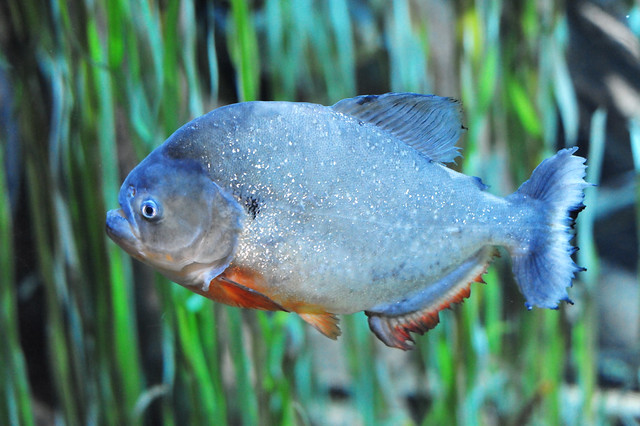Piranhas
 |
| Photo by Joybot |
BASIC PIRANHA FACTS
Piranhas have red throats, razor-sharp teeth to rip flesh with ease, and silvery gold flesh (red-bellies have red bellies, of course). Piranhas are native to South America and Guyana and it's against the law to bring them in and out of most countries. They are quite dangerous and aggressive fish since they reside in schools, which has a tendency to promote a competitive environment.
When planning a piranha aquarium , fish size should be regarded first. Grown piranhas have been known to develop to two feet long in a big enough tank. Piranhas are in addition group swimmers, which means they'll need room to roam. Strive to provide two gallons per each inch of piranha fish. An aquarium six feet long by two feet by two should allow ample hideouts. A minimum fifty-gallon aquarium is recommended.
, fish size should be regarded first. Grown piranhas have been known to develop to two feet long in a big enough tank. Piranhas are in addition group swimmers, which means they'll need room to roam. Strive to provide two gallons per each inch of piranha fish. An aquarium six feet long by two feet by two should allow ample hideouts. A minimum fifty-gallon aquarium is recommended.
 |
| Red-bellied piranha or Red piranha (Pygocentrus nattereri - Photo by warriorwoman531 (cc) |
TANK UPKEEP AND CONDITIONS
Piranhas (Pygocentrus (Serrasalmus) nattereri) are very sloppy eaters. Ten to fifteen percent water switch-outs every seven days will ensure waste not trapped by the filter system is taken away. Regarding filter systems, almost all piranha aquariums will need at least two devices to manage the process, especially if the aquarium is fifty or more gallons. Nitrate concentrations, which have harmful effects on piranhas particularly, should be monitored directly. PH levels ought to stay between six and one half and 6.9 to copy those of the Amazon where piranhas came from.
Water degrees in a piranha enclosure should be about eighty degrees to encourage piranha movements. Many piranha owners employ additional water pump devices to prod piranhas to swim in opposition to the waves as in the River of the Amazon . The practice additionally promotes metabolism levels, stimulating eating habits.
. The practice additionally promotes metabolism levels, stimulating eating habits.
For decoration, it's preferable to keep the fish tank low lighted to encourage piranhas to venture into open water. Man-made fauna is recommended. Any rocks and synthetic centerpieces will need to be tightly fastened, seeing as strong piranhas will hurl pieces around, potentially breaking the glass.
DIET
Piranhas' diet consists completely of proteins. Living meaty rations such as non-fatty poultry or beef and fillets of fish may be administered daily or bidaily. Feeder comet fish are a non-expensive choice, but piranhas will dine on practically any variety of meat. Experiment to find what yours favor. Whatever you do, don't leave your fingers in the water too long!
TANK MATES
Obviously, piranhas are aggressive fish, which makes your choice of tank mates relatively slim. However, some other aggressive fish can co-exist with them. For example, tetras, cichlids, Oscars, pleco catfish and pacus. These fish are by and large excellent defensive fish, while the plecos have tough outer shells and can grow to larger, intimidating sizes. Pacus resemble piranhas and will fight back. Tetras are quick and small with sensory instincts which allow them to stay clear of piranhas. Piranhas also aren't likely to give chase to such speedy, small cohabitants. Cichlids may or may not coexist with piranhas; they have simply been known to team up against them to survive. Oscars are large and in charge and inexpensive to replace if they're slurped by a fat red-belly.
As a rule of thumb, don't introduce too many new experimental tank mates into your piranha tank. Add them one by one to see how they adapt. Whatever you do, don't get too attached to them until you know they're going to make it!
SUMMARY
We hope you've benefited from this informational piece regarding piranhas. Feel free to visit AquariumUniverse.com for more piranha aquarium information including photos and videos, additional guides and aquarium resources.

No comments:
Post a Comment